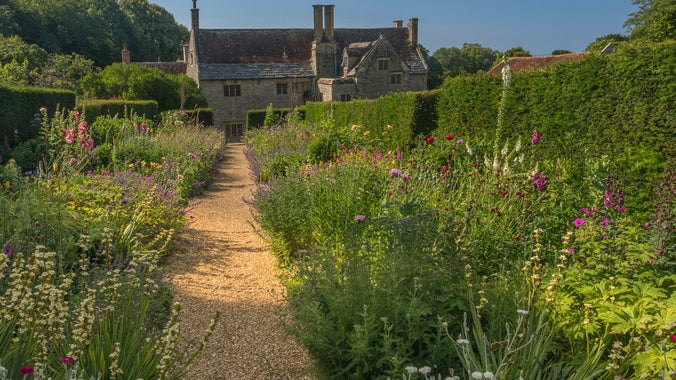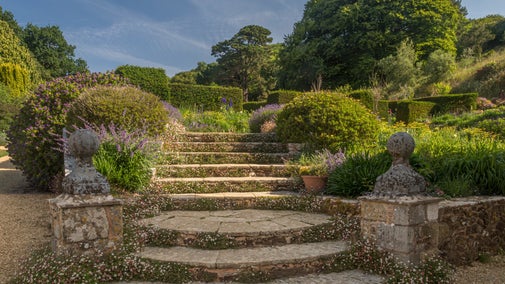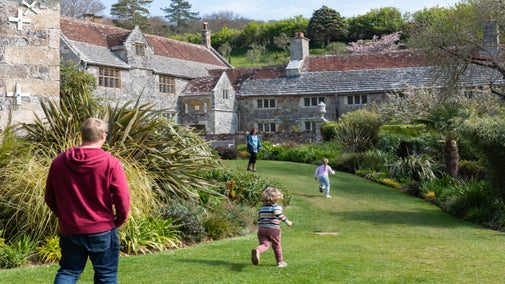
Become a member
Join today and help protect nature, beauty and history – for everyone, for ever. Enjoy access to more than 500 places with National Trust membership.
Enchanting gardens set in a sheltered valley and surrounded by rolling downland
Mottistone, near Brighstone, Isle of Wight, PO30 4ED

| Asset | Opening time |
|---|---|
| Garden | Closed |
| Countryside | Dawn - Dusk |
| Manor house | Closed |
| Ticket type | With Gift Aid | Without Gift Aid |
|---|---|---|
| Adult (18+) | £9.90 | £9.00 |
| Child (5-17) under 5s free | £5.00 | £4.50 |
| Family (2 Adults and up to 3 children) | £24.80 | £22.50 |
| 1 adult family | £14.90 | £13.50 |
| Group (Adult 18+) | £8.55 | |
| Group (Child 5-17) | £4.28 |
Second-hand bookshop located within the manor.
There is a free car park next to the gardens. Please follow the signs along the B3399. We don't allow overnight parking due to the impact on nature and wildlife, staff resource and visitors.
Within Mottistone Gardens, dogs on leads are welcome and water bowls are located outside the visitor reception and in the tea garden. Dogs are welcome across the wider estate. Please keep your dog on a short lead around livestock.
Plants are available to buy within the gardens.
Tea garden within the gardens serving hot and cold drinks, sandwiches, light bites, cakes and bakes.
Tea-room - more informationToilets available within the gardens. Please be aware that the main toilets are closed for upgrading work and temporary facilities are currently available, including baby-changing facilities.
Blue Badge spaces are available in the car park and located close to the exit to the gardens. If you are unable to manage the steps from the car park, a drop off facility is available at the front gate. 100 yards walk to reception from car park which includes five steps and a gravel path. Garden is partly accessible with a mixture of gravel and grass paths. There are some steep slopes and steps throughout the garden. Accessible toilet. Assistance dogs welcome.
Blue badge spaces are available in the car park and located close to the exit to the gardens.
A drop off facility is available at the front gate. If the blue badge holder is the driver, please contact us ahead of your visit and we can advise you on parking.
From the car park there is a short (100 yards) walk to Visitor Reception which includes a few steps and a gravel path. The grounds of Mottistone Gardens are partly accessible with a mixture of gravel and grass paths.
There are some steep slopes and steps throughout the gardens.
There are some steep slopes and steps throughout the gardens.
Discover all about visiting Mottistone, Isle of Wight, with your four-legged friend. Mottistone Gardens is a one pawprint rated place.

Set in a sheltered valley with herbaceous borders, exotic plants, olive grove and organic kitchen garden, surrounding an ancient manor.
A network of paths crosses the estate, from the sea up to the top of the downs. Neolithic Longstone, fort and barrows.
Take in the exterior of Mottistone Manor from the gardens, and see The Shack, a cabin retreat used as an architects' summer drawing office.
Takeaway hot and cold drinks, light snacks and seating in the tea-garden.
Discover a garden packed full of interest with deep flower borders, wandering paths, clipped hedging, an orchard and far-reaching views to the sea.

Discover the family-friendly things you can get up to in Mottistone Gardens. From exploring the gardens and woods, to ever changing trails, there's always something to keep little visitors entertained.

The Shack was a neat, compact retreat for 1930s architects Seely & Paget where they designed projects like Eltham Palace. It is still furnished as it would have been in their time.

With wide-open spaces and far-reaching views, there is plenty to do on the estate from walking and cycling to discovering remains of a Neolithic long barrow.

The tea-garden has treats for you to savour. Take a break from wandering the garden and relax with a refreshing drink, a slice of homemade cake, a cream tea, or a light lunch.

The views from the heather-covered Mottistone Common are the highlight of this walk, which also takes in a mysterious ancient monument.

A circular walking route that takes you south from Mottistone Gardens to the coastal cliffs at Sudmoor Point.


A beautifully restored farmhouse with plenty of space for the whole family and a large garden.

A large private garden and roses tumbling across its stone front make this cottage a stunning place to stay.

An ‘off the grid' period cottage that takes you back in time, Longstone is a rural hideaway set halfway up Mottistone Down.

A farm worker’s cottage a short walk from Compton Bay and with views of chalky cliffs and grazing cows.

One half of a pair of farm workers’ cottages close to Compton Bay close to the best surfing spots.

Set in a quiet backwater on the Newtown National Nature Reserve, this rustic, cosy cabin is surrounded by coastal paths and meadows, so it’s the perfect spot for a nature-filled break.

Right on top of the cliffs on the Needles headland, this spacious cottage has uninterrupted views of the sea, glorious sunsets and the night sky.

On the Needles headland, this characterful former coastguard’s house has views of the sea, the sunset and the night sky.
Sorry, there are no upcoming events at this place
The gardens
Set in a sheltered valley these magical gardens are full of surprises, with shrub-filled banks, hidden pathways and colourful herbaceous borders.
Created from an abandoned farmyard and surrounding an attractive Elizabethan manor house, these 20th-century gardens are experimenting with a Mediterranean-style planting scheme to take advantage of the warm, southerly location. Here the tall leaves of exotic plants fill the borders whilst a young olive grove is establishing itself on the high banks.
From late spring to early autumn, the borders burst with bright reds, purples and oranges and a small organic kitchen garden is stocked with seasonal fruit and veg.
The estate
Stretching from the chalk downs through rolling hedge-lined farmland and down to the sea, the wider Mottistone Estate is a landscape shaped over thousands of years. Follow the network of footpaths that criss-cross the area and you’ll travel back in time past Bonze Age barrows and the Neolithic Longstone.
Today the land is still cared for in a nature-sensitive way. Walk along any of the paths and you might spy butterflies gathering nectar from wild flowers, or rare birds in the wide skies overhead. In the summer, the elusive Nightjar even makes its home here on the common.
Next to Mottistone Gardens you’ll find the car park and bus stop, which are good places to start your visit. There are many well marked paths to choose from and large expanses of open downland to wander freely over.
There has been a dwelling on the site of Mottistone for over a thousand years. Discover how it evolved over centuries of changes and how it came through disaster.

Search for live volunteering opportunities, or register your interest with Mottistone Gardens and Estate.


Join today and help protect nature, beauty and history – for everyone, for ever. Enjoy access to more than 500 places with National Trust membership.
By sharing your email address you’re agreeing to receive marketing emails from the National Trust and confirm you’re 18 years old or over. Please see our for more information on how we look after your personal data.